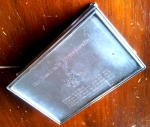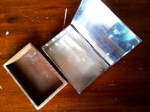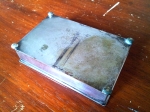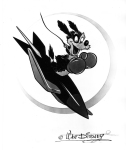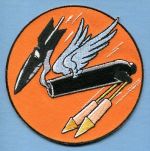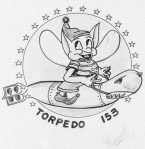Blog Archives
Researching to Establish Provenance: A Cigarette Box with Historical Connections
Posted by VetCollector
While much of my militaria collection consists of family-connected items (such as uniforms, decorations, documents and photographs) I also have some oddities that serve to add interest and perhaps to make a display more visually aesthetic. In reviewing the (online displays of) collections from other enthusiasts, it is quite easy to see that many of them have focused their attention upon such areas as service branches, theaters of combat, veterans’ groupings, decorations and medals to list the most prevalent.
-

- These Coca-Cola branded “Airplane Spotter” playing cards are a great example of a cross-over collectible. Collectors of Coke memorabilia, militaria and even of playing cards would enjoy these in their collection (source: eBay image).
-
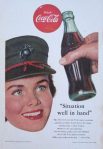
- Military-themed advertising is another example of collectibles that have cross-over appeal (source: eBay image).
-
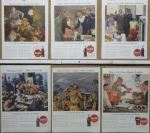
- Plucked from the pages of magazines such as “Life,” these colorful, patriotic adverts look fantastic dislayed with other Coca-Cola memoriabilia or militaria (source: eBay image).
Crossover collecting can be even more rewarding due to the uniqueness that it offers the enthusiast. For example, an individual may already be a collector of memorabilia from a commercial company such as Coca-Cola (focusing on signage, advertising, drinkware, etc.) who then discovers a militaria sub-set within that area of collecting. Other areas of militaria crossover can include Tobacciana, Zippo lighters and my personal favorite, baseball.
The piece that I am focusing this article on does fit into a crossover the tobacciana category but hardly signifies that my interests are branching into that area of collecting. This artifact fits into another crossover facet of collecting that is more my speed: folk art or, in military terms, Trench Art. As an amateur military historian and someone who enjoys artifacts related to the U.S. Navy, this cigarette box was something of interest to me. I also thought that the piece would look great on my dresser and serve as a storage place for personal items while fitting in alongside of my other antique boxes.
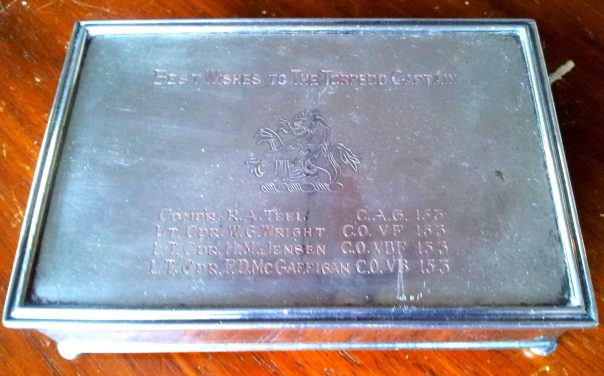
I have owned this silver cigarette box for several years but never spent any significant time researching it.
The cigarette box is engraved with “Best Wishes to the Torpedo Captain” along with a griffin and a list of naval aviators and their commands (part of Air Group 153). When I first acquired this piece, I assumed it was made from scrap metal – possibly obtained from an aircraft part – and crafted by a squadron aviation structural mechanic. As the box has since been displayed for the last few years, the surface has tarnished which leads me to suspect that the metal material is silver. The absence of any hallmarks means that the only way to determine the material composition is to perform one or more tests (hopefully) without damaging the artifact.
As with other militaria artifacts, especially named pieces, researching is part of the enjoyment (and sometimes the pain when research hits a dead-end) and though the collector that I purchased this from included some information, I pursued the information further. Examining the engraving, the names are listed out:
COMD’R. R. A. Teel, CAG 153
L.T. CDR. W.G. Wright, C.O. VF 153
L.T. CDR. H. M. Jensen, C.O. VBF 153
L.T. CDR. F. D. McGaffigan C.O. VB 153
Judging by the present information, one would think that the odds to identify the box’s original owner might be fairly descent, and with good reason considering that there were nine data points (ten, if one includes the griffin and the presentation statement) to base the research upon. Understanding nomenclature, rank abbreviations and the numerics of naval aviation squadrons is a good starting point. Navy rank abbreviations during WWII were a bit more complex than the simplified modern counterparts. Officer rank structure can be defined easily:
| Rank | WWII Abbreviation |
Current Abbreviation |
| Ensign | Ens. | ENS |
| Lieutenant Junior Grade | LT.j.g. | LTJG |
| Lieutenant | LT. | LT |
| Lieutenant Commander | L.T. CDR. | LCDR |
| Commander | COMD’R | CDR |
| Captain | CAPT. | CAPT |
For those who are new to naval aviation squadron designations and their meanings, “V” is the designation for fixed wing aircraft. For the sake of brevity and keeping this post focused on these specific squadrons, I’ll refrain from providing definitions for all WWII naval aviation squadrons.
- CAG – Commander, Air Group
- VF – Fixed Wing Fighting Squadron
- VBF – Fixed Wing Fighting/Bombing Squadron
- VB – Fixed Wing Bombing Squadron
Commander, Air Group 153 (listed above as “CAG”) with Commander R. A. Teel, was the group commander who was responsible for the squadrons within his group (VF-153, VBF-153 and VB-153). Lieutenant Commanders W.G. Wright, H.M. Jensen and F.D. McGaffigan were commanding officers of the subordinate squadrons reporting up to Commander Teel. Successfully researching the information (names, squadrons) will certainly help to provide great information but I have no way of determining the original owner of the box (to whom it was presented). Being geographically located at the farthest reaches from the National Archives or the Naval History and Heritage Command in Washington, DC (while still residing within the contiguous United States) limits the scope of research. I am resigned to scouring the fractional data that is available online.
The ultimate goal of my research was to determine the identity of the original owner of the cigarette box which, when I purchased it, was thought to have been one of the aviators named in the engraving. Judging by the inscription, “Best Wishes to the Torpedo Captain,” that title, in my estimation, refers to the commanding officer of the squadron of torpedo bombers. Being that all of the other listed squadrons were either fighter, fighter-bomber or bomber squadrons, it would seem that the Torpedo Captain would have been the skipper of the Air Group’s VT squadron, which was not engraved onto the box.
Before proceeding further, I sought to confirm that the air group’s assigned VT squadron also shared the same numbering convention. A quick search led me to a very limited listing of Air Group One Fifty Three (ComAirGrp 153). Indeed, the composition of the group consisted of four squadrons:
- VB-153 (composed of 15 VSB aircraft, or fixed wing scouting bombers)
- VF-153 (composed of 36 VF aircraft, or fixed wing fighters)
- VBF-153 (composed of 36 VF aircraft)
- VT-153 (composed of 15 VTB aircraft, or torpedo bombers)
While this information was a solid initial step, the source lacked further confirmation regarding any of the engraved names on my box. As I write this article, I await a response from a fellow collector who has access to naval aviation records. Turning my attention to the names listed on the case, I do have a few avenues in which to proceed in order to get a clearer picture of the careers of these naval aviators. When I received the box, inside was a folded-up printout (of a WWII Memorial entry for Francis D. McGaffigan) that provided me with a head start for one of the box’s engraved names.
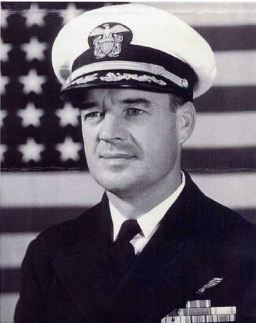
Captain Francis Daniel McGaffigan (source: WWII Memorial).
Lieutenant Commander F. D. McGaffigan, my research revealed, was born January 13, 1910, to Irish immigrants in Boston, Massachusetts. After graduating high school, he enlisted as a Seaman Second Class and was assigned to Naval Aviation Elimination Training in Boston (shown in official records as “Squantum”) in January of 1940. According to his memorial page (submitted by a family member), the naval aviator served with a number of commands during WWII. I’ve spotlighting a few:
- Commanding Officer, Bomber Squadron (VB) 306, flying SBD-5 Dauntless , Solomon Islands
- Commanding Officer, Bombing Squadron 99, Saipan
McGaffigan’s career as listed by his relative is highlighted with the following post-war assignments. Subsequent research could determine what, if any, wartime service the captain might have experienced prior to the conclusion of his career.
- Commanding Officer, Bombing Squadron 150, USS Lake Champlain (CVS-33)
- Commanding Officer, Bomber Squadron 153, USS Kearsarge (CV-33)
- Air Officer, USS Essex (CV-9)
- Commanding Officer, Naval Air Reserve Training Unit, NAS Lakehurst (NJ)
Captain McGaffigan’s awards and decorations which include:
- Distinguished Flying Cross
- Air Medal (3)
- Naval Reserve Medal
- American Defense Service Medal
- Asiatic–Pacific Campaign Medal (with campaign star)
- American Campaign Medal
- World War II Victory
McGaffigan’s post-naval life commenced with retirement in 1960, and he lived out his year, passing in 2001.
After searching through the careers of the naval aviators listed on the box, it is clear that the name that was absent is the one who was presented with the box from the remainder of those listed, starting with the Commander Air Group (CAG), Commander Richard A. Teel.
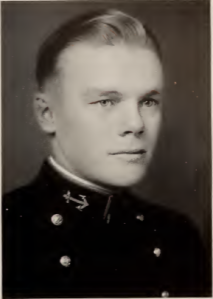
Richard Ashley Teel’s 1936 Naval Academy graduation portrait (source: The Lucky Bag).
Commander Richard Ashley Teel was born on Christmas Day, 1913 in Annapolis, Maryland (his father, Roland M. was a boy’s school principal and his mother, the former Susan B. Ashley, was an English immigrant homemaker), and after completing high school (at Severna Park H.S.), he entered the United States Naval Academy in June of 1932. Upon his graduation and commissioning, Teel was assigned to the battleship, USS New Mexico (BB-40). In 1938, LTJG Teel reported to Naval Air Station Pensacola for aviation training. Teel’s first assignment upon receiving his naval aviator’s wings was with the newly formed Bombing Squadron Seven (VB-7) aboard the USS Wasp (CV-7) in 1939. By 1942, VB-7 was redesignated a fighter squadron (VF-71) and was transferred to shore-based operations on Espirtu Santo following the sinking of the Wasp in September of 1942 (she was torpedoed by a Japanese submarine). After VF-71 was disbanded, LT Teel was flying from the USS Independence (CVL-22). Considering that Commander Teel is not the focus of this research, I ceased pursuing his career further. I was able to find that Captain Richard Teel retired after thirty years of service on July 1, 1966, and enjoyed another 28 years, passing on August 9, 1994. Richard Ashley Teel’s final resting place (the Naval Academy Cemetery) is not far from his birth home in Annapolis.
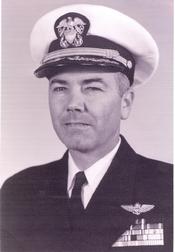
Commander Wilson George Wright III.
Lieutenant Commander Wilson George Wright III was born in Ogden, Utah, on May 15, 1916, to Wilson G. and Lelia D. Wright. He graduated from Ogden High School, and attended Weber College for one year and then entered the U.S. Naval Academy in June of 1935, and was commissioned an ensign on June 1, 1939. Following graduation from the Naval Academy, Wilson served one year on the battleship USS Idaho (BB-42) and one year on the USS Lamson (DD-367). Wright reported to NAS Pensacola for flight training and was designated a Naval Aviator on December 16, 1941. His first aviation duty was in VF-71 aboard USS Wasp (CV-7) and flew combat missions surrounding Guadalcanal in support of the First Marine Division landings during the invasion of Guadalcanal, August 7-8, 1942. LTJG Wright was aboard when the Wasp was torpedoed and sunk by Japanese submarine I-19 near San Cristobal Island in the Solomon Islands.
Wright’s next assignment was as Executive Officer of VF-33 which was land-based in the Solomon Islands, flying many combat missions including fighter sweeps and bomber escort missions over Rabaul.
Following six months as a Fighter Type Instructor at the Naval Air Station Atlantic City, he was ordered to the Naval Air Station Grosse Ile, Michigan, to start and commission Air Group 97, and served in that unit as the Commanding Officer of Fighter Bomber Squadron 97. He was awarded the Navy Commendation Medal for his service in Air Group 97. Upon the decommissioning of Air Group 97, Wright’s next assignment was as the commanding officer of Fighter Squadron 153, followed by a tour as the commanding officer of the Flag Administrative Unit and finally, as the staff personnel officer of Commander Fleet Air Alameda.
Following his retirement, having attained the rank of commander, Wright worked as an engineer and supervisor in the aerospace industry, spending three years with the Lockheed Missile Division on the Polaris Missile project, 17 years with Rockwell Space Division and was involved with the lunar landings and the Space Shuttle programs. He was 95 years old when he passed away on Nov. 2, 2011, and was laid to rest in home state of Utah.
Among Wright’s numerous awards and decorations were:
- Distinguished Flying Cross
- Air Medal (5)
- Navy Commendation Medal
- American Defense Service Medal
- Asiatic–Pacific Campaign Medal
- American Campaign Medal
- World War II Victory
The last of the names listed turned out to not only be notable, but he earned the status of an Ace fighter pilot (meaning that he had five confirmed air-to-air enemy kills) during his service with VF-5.
Lieutenant Commander Hayden Martin Jensen was born on January 30, 1911, in St. Paul, Minnesota where he attended high school and college. Jensen was commissioned an ensign on August 19, 1939. Having completed flight training, Ensign Jensen was assigned to Bombing Squadron Five (VB-5, part of the Yorktown Air Group), flying the Northrop BT-1 aboard the USS Yorktown (CV-5). By 1941, the young ensign had transferred to VF-5 (the “Stafighters”) as his role changed from a bombing to a fighter pilot, flying the F4F-3 Wildcat. Still assigned to VF-5 when it was transferred to the USS Saratoga (CV-3) in June of 1942, Jensen would meet the enemy in the South Pacific – in the Guadalcanal Campaign – in two separate engagements in August of 1942, twice earning the Navy’s second highest valor decoration, the Navy Cross, scoring two enemy kills on August 7, 1942, and three more on August 24. For these engagements, LT Jensen was also awarded the Distinguished Flying Cross. LCDR Jensen assumed command of VBF-153 on March 26, 1945.
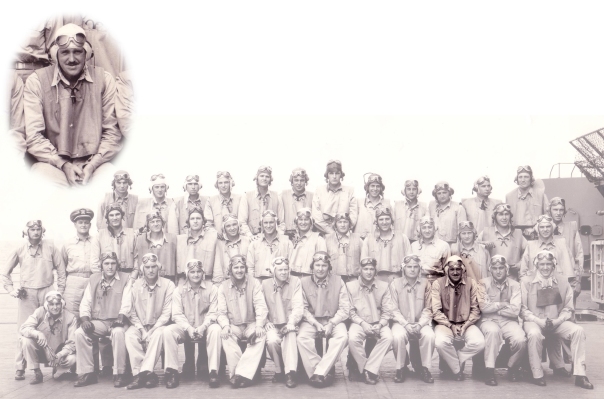
LT Hayden Jensen poses with the men of VF-5 aboard the USS Saratoga, July 15. 1942. In a little more than two weeks, Jensen will have his first two of five enemy air kills.
Jensen married the former Henrietta Mathilda Schirmer (also of St. Paul) on December 27, 1938. Still serving on active duty, 38 year-old LCDR Jensen passed away on June 6, 1949, at Naval Hospital Newport, Rhode Island, with his wife, Henrietta by his side. He was laid to rest at Arlington National Cemetery.
Among Jensen’s numerous awards and decorations were:
- Navy Cross Medal (2): see citations
- Distinguished Flying Cross Medal
- Air Medal (3)
- American Defense Service Medal
- Asiatic–Pacific Campaign Medal
- American Campaign Medal
- World War II Victory Medal
After reviewing the incredible service details for these four naval aviators, I was convinced that the box never belonged to any of the men listed on the box. Based upon their careers, none could be considered as “The Torpedo Captain” leaving me to pursue the next logical step. As with each naval air group, I confirmed that Air Group One Fifty Three did, in fact, have a torpedo squadron (VT). Cursory internet searches were dead-ends as far as attempting to discover possibilities of assigned commanding officers. Fortunately, I am a member of an amazing group of fellow collectors on the U.S. Militaria Forum where there are folks who possess years of experience and knowledge and have access to records and sources. I posted some requests for assistance and like clockwork, two members answered me and began to fill in the blanks. Instantly, I had the names of two naval aviators who commanded VT-153: LCDR H.C. Madden and his successor, LCDR F.G. Lewis.
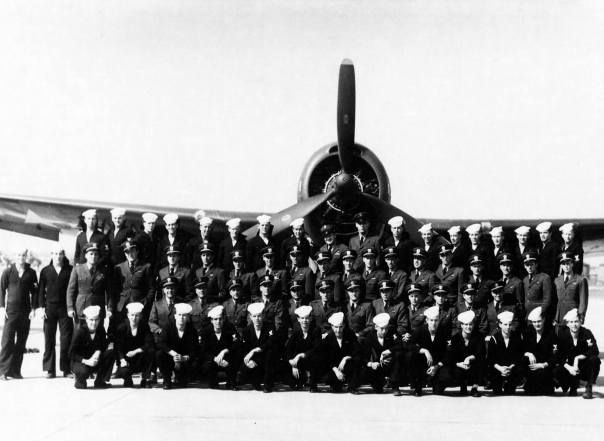
The officers and men of Torpedo Squadron 153 (courtesy of Jack Cook).
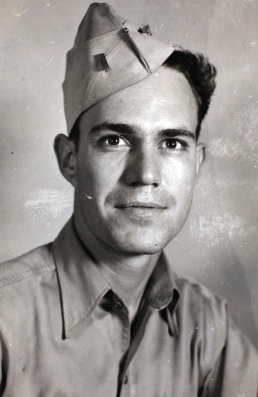
LTJG Harlan C. McFadden Jr.
LCDR Harlan Curtis McFadden Jr. was born June 29, 1918. After completing high school in Clayton, New Mexico, McFadden pursued his degree in English Literature at the University of New Mexico before enlisting as a naval aviation cadet on July 9, 1941. He began six weeks of elimination flight training at Naval Air Station Long Beach, California and, upon completion, McFadden commenced flight training at NAS Corpus Christi for 44 more weeks. Harlan finished his final 12 weeks of operational flight at NAS Ft. Lauderdale.
LT McFadden was assigned to Torpedo Squadron Three Hundred Five (the “Red Asses”) from 1943-44. On August 1, 1944, when VT-305 was ordered decommissioned, McFadden was transferred to VT-99 along with five fellow flyers and additional enlisted support personnel. Much of his early months of service during the war were spent flying missions over various Japanese strongholds in the Solomon Islands, such as Bougainville and Rabaul. On March 26, 1945, LCDR McFadden assumed command of VT-153 at Naval Auxiliary Air Facility (NAAF) Lewiston in Maine. One of McFadden’s assigned aviators was LT George H. W. Bush who served with the squadron from March through September of 1945. Ten days after the squadron was activated, Mcfadden was relieved of command by LCDR Lewis. From April 6 through his discharge on September 5, 1945, I have been unsuccessful in locating McFadden’s naval service or why he was relieved of command. In his four years of service as a naval aviator, McFadden saw a total of 14 (four months in the North Atlantic and 10 in the South Pacific). On his separation documents, McFadden stated that he was pursuing a career in commercial aviation.
LCDR Frederick Gary Lewis was born on March 13, 1916, in Springfield, Massachusetts. Though I have had some success in researching Lewis, I have not been as successful in discovering as much detail regarding his life and the breadth of his time as a naval aviator. He was commissioned an ensign on November 14, 1940, and was assigned to the fleet aboard the battleship USS Pennsylvania (BB-38) as the Communications Officer. Ensign Lewis was present aboard the ship during the Japanese attack on Pearl Harbor, witnessing the carnage and utter destruction on the ships and facilities surrounding the Pennsylvania, including the tremendous damage inflicted upon the destroyers USS Cassin (DD-372) and USS Downes (DD-375) which were sharing the same drydock as the battleship. As the battleship was floated and directed to San Francisco for repairs, LTJG Lewis reported for flight training at Naval Air Station Pensacola. Once Lewis received his wings of gold, he was assigned as a flight instructor at NAS Ft. Lauderdale where he served for the next twelve months. In December 1943, LT Lewis took command of Composite Squadron Seventy-Eight (VC-78) aboard the USS Saginaw Bay (CVE-82). His only combat action that he experienced was in support of the liberation of the Philippines in October of 1944. Receiving a temporary promotion (to LCDR) prior to relieving LCDR McFadden on April 6, 1945, serving as VT-153’s commanding officer until June 1946.
Other than Lewis’s permanent promotion to LCDR in 1950, I was unable to find anything further regarding his naval career. Frederick Lewis passed away on April 7, 1978 at the age of 62 in San Leandro, California.
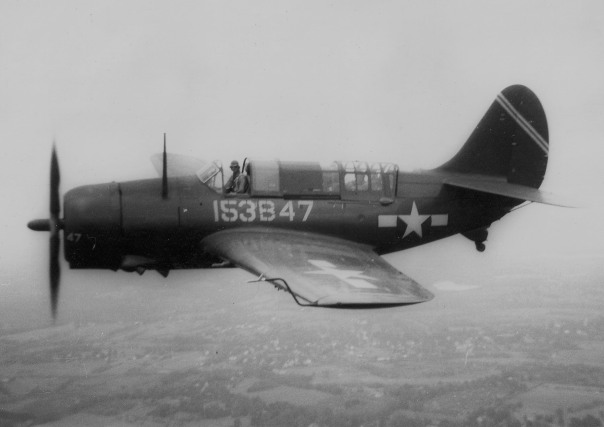
SB2C of VT-153 courtesy of Jack Cook.
After diving deep into each of the men, I had one remaining piece of information left to work through – the insignia of the griffin that was engraved on the top of the cigarette box. I started to seek insignia for all of the listed squadrons. I was able to locate just two insignia and squadron nicknames: VBF-153 was listed as the “Copperheads” though the corresponding insignia that I found didn’t seem to fit the name (more research to follow); VB-153 was known as the “Flying Cannons” and its insignia seemed to fit perfectly.
My contact at the U.S. Militaria Forum provided me with the insignia for VT-153 which added confusion; the “Gremlins” as they were known, did little to support my thought that the griffin on the box bore some significance, however, that isn’t where my trail ended. Following the lineage of each squadron, I found that VA-153 (“A” for attack squadron, the current designation for a carrier-based fixed wing bombing aircraft), which was disestablished in 1977, employed a very similar-looking griffin in their logo. The two griffin appearances is more than likely coincidental but it certainly leaves me with the idea that there is some connection.
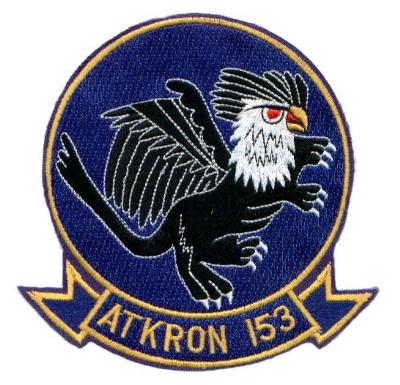
Attack Squadron 153’s insignia – a griffin – (as seen on their unit patch) has to be more than mere coincidence considering the similar image on the cigarette box
Ultimately, my research did not provide me with any sort of definitive evidence that I could use to pinpoint the original owner of my silver cigarette box. I am deducing that it was most likely given to LCDR Frederick G. Lewis from his air group colleagues near or after the end of World War II.
Read more about collecting unusual militaria:
Posted in Military Folk Art, Theater-made Militaria, Trench Art, US Navy, World War II
Tags: Cigarette Box, Commander Richard Ashley Teel, Distinguished Flying Cross Recipients, LCDR Frederick Gary Lewis, Lieutenant Commander F. D. McGaffigan, Lieutenant Commander Hayden Martin Jensen, Lieutenant Commander Wilson George Wright III, LTJG Harlan C. McFadden Jr., Naval Aviation, Navy Cross Medal Recipients, VB-153, VBF-153, VF-153, VT-153, World War II, WWII Naval Aviators

